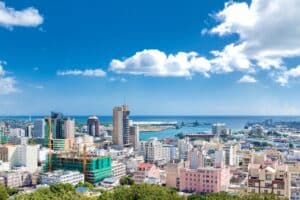Seychelles is a group of 115 gorgeous islands scattered across the Indian Ocean and waiting to be explored. Its capital, Victoria, is one of the tiniest capitals globally—so small, you can cover it on foot in a single day. As for safety?
Great news! As of 2024, there’s no red alert keeping you away from Seychelles—it’s a pretty safe spot to visit. But, of course, a little sprinkle of caution never hurts, so we’ll cover all grounds when it comes to your safety, including crime, natural disasters, and much more.
Are you planning a last minute trip to Seychelles? We’ve put together all the resources you’ll need for a fun & safe travel:
🛌 Best & Safest Places to Stay in Seychelles:
👉 Château de feuilles – Outdoor swimming pool, Bar, Family rooms
👉 Chateau Elysium – Beachfront, Airport shuttle, Tea/coffee maker in all rooms
👉 Dhevatara Beach Hotel – Beachfront, Free WiFi, Spa and wellness centre
👉 Hotel Le Duc de Praslin – 3 restaurants, Private beach area, Free WiFi
⛱️ Fun Activities & Tours in Seychelles:
👉 Anse Marron Tour
👉 Semi Submarine Tour in Saint Anne Marine National Park
👉 Island tour with the beach buggy
🚗 Best & Safest Seychelles Transportation Services:
👉 Airport Pickup Service – Welcome Pickups
👉 Rent a Car – DiscoverCars
🙏 Stay Safe While Travelling:
👉 Safetywing (for medical insurance)
👉 VisitorsCoverage (for trip insurance)
Is Seychelles Safe?
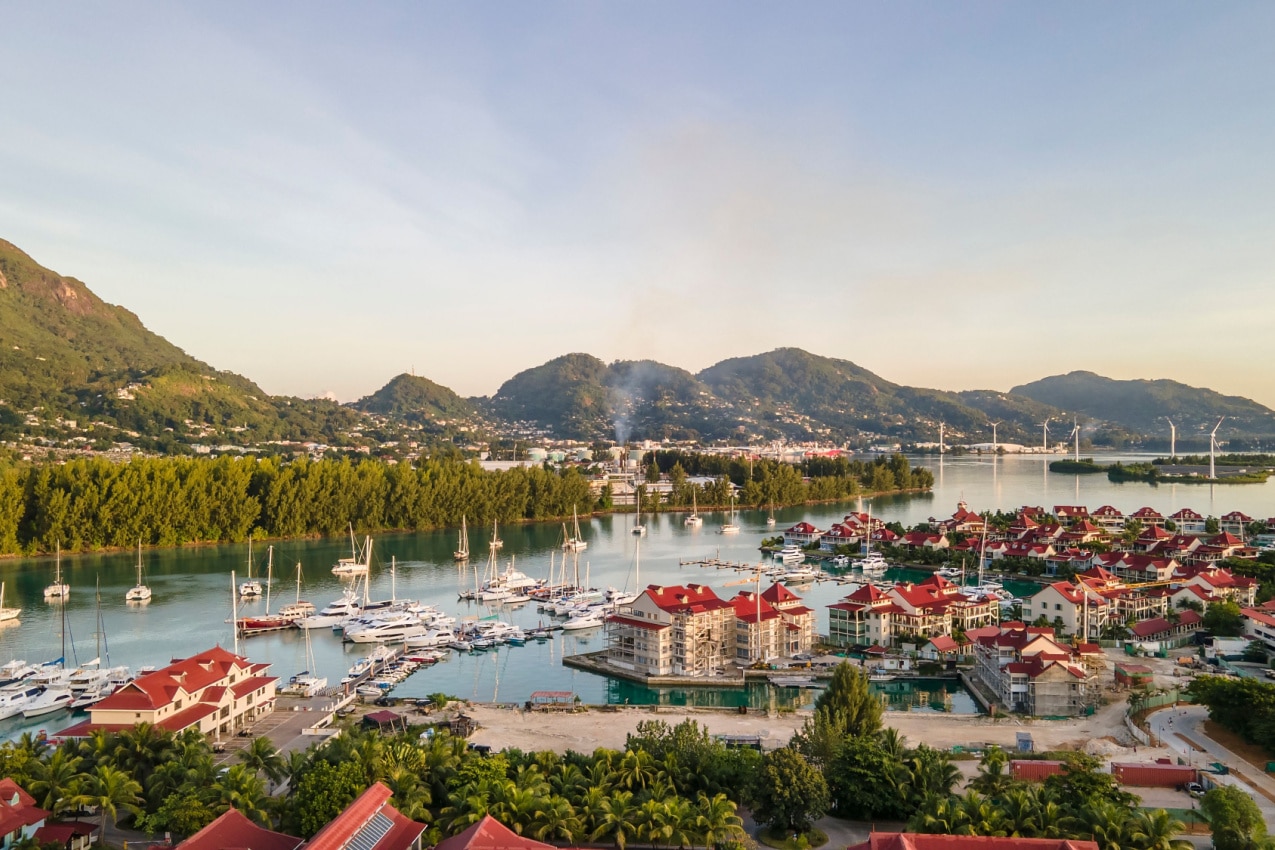
Yes, Seychelles is a safe haven for travelers. Beyond the usual precautions you’d take anywhere—like keeping an eye on your belongings—this island paradise is largely worry-free.
The worst hiccup might be a petty crime, like pickpocketing, or an occasional hit of a tropical storm. Nothing too alarming, though.
Here’s what to expect on the safety front in Seychelles:
- International travel advisories: Level One, practice normal precautions
- Crime rating: Moderate, 43.97
- Most common crimes: Road traffic accidents, public order offenses, and drug-related incidents
- High-crime areas: Popular tourist areas including Beau Vallon and Victoria, beaches like Cote d’Or beach, and public ATMs
- Public transportation safety: Getting around is safe, but bus rides are limited to Mahé and Praslin; taxis are available on the two islands as well as in La Digue
- Safety walking alone during the day: High
- Safety walking alone during the night: Medium
- Road safety: Some streets may lack proper lighting and barriers
- Beach safety: Popular beaches like Beau Vallon Beach on Mahé Island are safe thanks to vigilant lifeguards on duty; however, more secluded beaches may lack such supervision
- Tap water: Up to standards, but it’s highly chlorinated on some islands
- Common natural disasters: Tropical cyclones, floods, and landslides
- Carbon monoxide: CO poisoning is possible, check with the hotel staff whether your room has a CO detector, or purchase a portable one
- Police presence: More present on the larger, more populated islands; less pronounced in remote areas
- Medical care quality: Some of the best medical care quality in the African region
Travel Advisory for Seychelles
The United States, Australia, Canada, Ireland, New Zealand, and the United Kingdom travel advisories all place Seychelles under Level 1, advising visitors to “practice normal precautions.”
Here’s a quick safety snapshot from the advisories:
- Possibility of petty crime, like pickpocketing and purse snatching.
- Outdoor adventures can be a bit tricky if you’re not prepared, especially with changing weather conditions and unmarked trails.
- Coastal waters can be dicey, with strong currents, riptides, and sharks in some areas.
- Lifeguards aren’t always on duty at the beaches.
- Taxis are available, just agree on the fare upfront.
- Coastal waters in the Gulf of Aden and the Indian Ocean have seen their share of pirate attacks. Less common now, but mariners—be wary.
A Comprehensive Look at Seychelles Crime Rates
Seychelles has a moderate crime rating of 43.97.
According to the National Bureau of Statistics (NBS), the most reported crimes in 2023 were road traffic accidents, public order offenses, and drug-related incidents.
In the first quarter of 2023, Seychelles clocked in 358 public order offenses, 4,019 road traffic accidents, and 284 drug-related incidents.
Looking back at 2022, the first quarter of 2022 had higher public order offenses at 505, lower road traffic accidents at 3,667, and fewer drug-related incidents at 85.
Despite its challenges, Seychelles is generally safe. Most violent crimes don’t typically target foreigners. As international travel advisories have confirmed, Seychelles is safe to visit, but it’s always wise to practice normal precautions to ensure your safety.
| Safety Concerns | Crime Rating | Status |
| Overall Crime Level | 40 | Moderate |
| Increase in Crime (Past 3 Years) | 76.32 | High |
| Home Break-Ins and Thefts | 55 | Moderate |
| Mugging and Robbery | 41.25 | Moderate |
| Car Theft | 28.75 | Low |
| Theft from Vehicles | 45 | Moderate |
| Personal Attacks | 37.50 | Low |
| Verbal Insults | 35 | Low |
| Racial, Ethnic, Gender, or Religious-Based Attacks | 26.25 | Low |
| Drug Use and Dealing | 61.25 | High |
| Property Crimes (Vandalism and Theft) | 51.25 | Moderate |
| Violent Crimes (Assault and Armed Robbery) | 37.50 | Low |
| Corruption and Bribery | 62.50 | High |
| Safety Walking Alone in Daylight | 77.50 | High |
| Safety Walking Alone at Nighttime | 52.50 | Moderate |
Source: Numbeo, 2024 data, based on 20 contributors
Police Presence in Seychelles
The Police Force of Seychelles is more present on the larger, populated islands, and less pronounced in remote areas.
As of 2023, Seychelles has an official Tourist Police team. This specialized unit is part of the Seychelles Police and focuses on preventing tourism-related crimes and enhancing overall safety, contributing to the positive image of the destination.
Communication won’t be a barrier with the police officers. While Seselwa is the primary language of the country, locals also speak and understand French and English. So, rest assured, the police will communicate with you in English during times of need.
Feel free to approach the police if you need directions or protection, or have general questions about Seychelles—they’re there to assist you. In case the police approach you for any reason, be polite and have your identification documents handy. Overall, your experience will be positive, as long as you stay on the right side of the law.
Public Transportation Safety in Seychelles
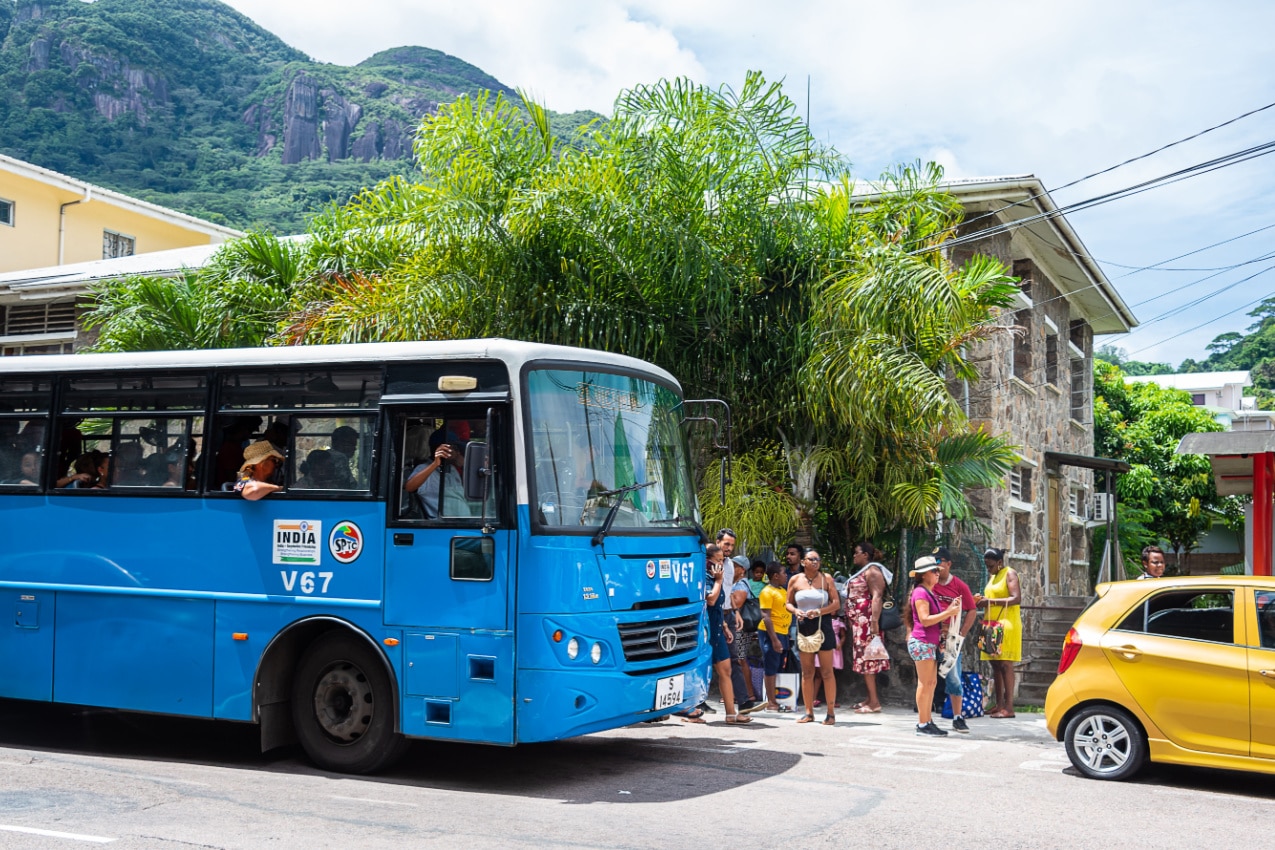
Getting around in Seychelles is safe, but transport options vary across the islands.
On larger islands like Mahé and Praslin, you’ll find public buses and taxis. The capital, Victoria, has a bus terminus where you can grab a timetable for island bus routes. Buses run hourly from 6 am to 6 pm, so don’t miss your ride!
Taxis are safe and convenient. They are mainly accessible on Mahé and Praslin, but you can also find them on La Digue (although their numbers are few). Seychelles taxis usually lack meters, so settle on a fare before your journey.
If you’re on the smaller islands like Bird Island or Desroches Island, you can walk or bike your way around.
For island hopping, there are boat services between Mahé, Praslin, and La Digue, but they can get pretty crowded with tourists, so book your spot as early as you can. Pay attention during the safety briefing, don’t hop on overcrowded boats, and don’t forget to strap on a lifejacket.
Road Safety in Seychelles
Driving in Seychelles is a great way to explore, but be mindful of the road conditions.
Driving is on the left side and speed limits are low, usually 25 to 40 mph (32 to 64.3 km/h). Some streets lack lighting and barriers, so when you’re driving around the islands, do so with caution, especially during heavy downpours that can reduce visibility. Road accidents in Seychelles are common, so stick to the recommended speed limits and check live traffic conditions for any disruptions.
Medical Care Quality in Seychelles
Seychelles has some of the best medical care quality in the African region.
Here’s your list of go-to hospitals for medical care in Seychelles:
- Anse Royale Hospital – 4388467
- Baie Ste Anne Hospital – 4232333
- Seychelles Hospital – 4388000
- Anse Aux Pins Health Centre – 4388468
- Anse Boileau Health Centre – 4355555
- Baie Lazare Health Centre – 4234255
- Beau Vallon Health Centre – 4388491
- Beoliere Health Centre – 4355555
- English River Health Centre – 4388577
- Glacis Health Centre – 4385001
- Grand Anse Praslin Health Centre – 4233414
- Les Mamelles Health Centre – 4388475
- Mont Fleuri Health Centre – 4388470
- Souvenir Health Centre – 4355555
- Takamaka Health Centre – 4361151
- Youth Health Centre – 4388585
Medical care in Seychelles is pricier in private clinics than in public ones. In any case, we recommend that you arrange health insurance before traveling. Consider options like Visitors Coverage, Insured Nomads, and Safety Wing for peace of mind.
Is It Safe to Travel Solo in Seychelles?
If you’re traveling alone, be extra cautious as you might be seen as an easy target by potential thieves.
Opt for daytime travel as crime tends to spike after dark. If you ever feel unsafe, the Seychellois police will be there to assist. If hiking’s your thing, consider hiring a guide for safety or joining a guided tour. Don’t roam around nature alone. And of course, before you book a tour, ensure that the guide is reputable and well-reviewed.
Going completely off-grid isn’t the best idea, so drop a call or message every now and then to keep your close ones up-to-date on your whereabouts and adventures.
Perils of Nature: The Risk of Natural Disasters in Seychelles
Seychelles occasionally face challenges from cyclones, flooding, and mudslides.
Tropical Cyclones
Fortunately, Seychelles doesn’t have to deal with hurricanes. However, from December to March, it steps into cyclone season.
December and January mark the peak of cyclone season, but the chance of a cyclone disrupting your vacation during these months is quite low. Rain, however, might be on the radar.
Cyclones don’t strike immediately; some hit land a few days after forming, while others change direction before reaching land. If, by rare chance, a cyclone is approaching, you’ll have ample time to take action. The key is to stay away from the beach and skip water sports like surfing. Unpredictable water conditions with strong winds and big waves can be risky. Pack an umbrella or raincoat and plan indoor activities until the weather clears.
Floods
During the cyclone season from December to March, heavy rainfall occurs and the islands are at risk of flooding.
Early December of 2023 witnessed substantial rainfall in Seychelles, resulting in floods and landslides. Sadly, on December 8, three people lost their lives up north on Mahé Island, and houses and roads got flooded and destroyed.
If you find yourself in the midst of a flood, roads might shut down, and public transport could experience some delays or even come to a halt. Follow directions from the local authorities to stay safe. Keep an eye on the weather updates, steer clear of flooded areas if you’re driving, and relax indoors until everything settles.
Landslides
Typically, landslides follow heavy rain or seismic activity. While earthquakes aren’t common in Seychelles, heavy rainfall is a likely trigger.
The recent landslides occurred in early December due to heavy rainfall, which also caused flooding and three unfortunate fatalities, as mentioned earlier. So, when planning your stay in Seychelles, avoid places with a landslide history. More importantly, avoid hiking or driving in areas prone to landslides during or after heavy downpours.
Beware the Silent Threat: Carbon Monoxide Poisoning in Seychelles
Seychelles hasn’t had any cases of carbon monoxide poisoning in 2023, but the risk from this silent threat is worth mentioning.
Carbon monoxide (CO) is a colorless, odorless gas produced by the improper burning of fossil fuels. Since this gas is basically undetectable by our senses its presence often goes unnoticed, leading to poisoning and severe health issues—even fatalities.
In Seychelles, a potential source of a CO leak during your vacation could be a faulty appliance, such as a stove or water heater. So before you book, check with the hotel staff about having CO detectors in the rooms. These work like smoke detectors, making noise if there’s too much CO. If you’re feeling extra careful, throw a portable CO detector into your travel bag.
Serenity by the Shore: The Safety of Seychelles Beaches
Seychelles beaches are not just stunning—they’re also safe. Beau Vallon Beach on Mahé Island is a gem when it comes to safety: a protective reef, calm waves, and vigilant lifeguards on duty.
However, the more secluded spots might lack lifeguard coverage. To ensure a fantastic beach day, have a chat with a local about the beach you want to visit.
While sunbathing, keep these precautions in mind:
- Keep a close eye on your belongings
- Slather on sunscreen to get ahead of the scorching sun
- Stick to the marked swimming areas
- Avoid solo swims, especially after dark
- Don’t swim if you’ve had a drink
- Wait 30 minutes after eating before entering the water
- Don’t swim in channels reserved for boats
Seychelles Weather Patterns: What to Expect
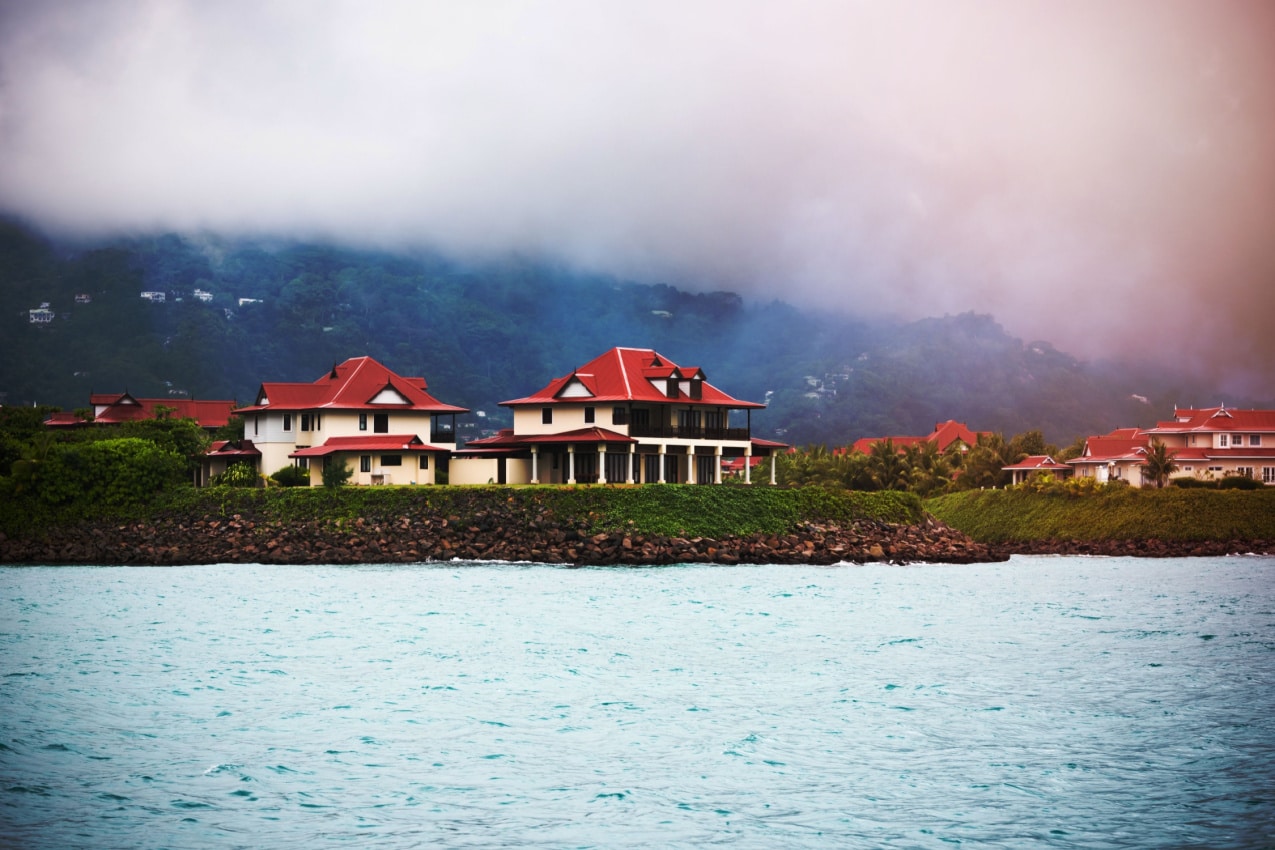
The Seychelles archipelago boasts an inviting tropical climate.
The temperature typically ranges between 75°F and 86°F (24°C and 30°C), with even early mornings staying comfortably above 68°F (20°C) year-round.
The rainy season runs from November to March, thanks to the northwest monsoon, while the June-to-September period brings drier and slightly cooler weather with southeast trade winds.
Tropical rains during the rainy season typically manifest as intense downpours or thunderstorms mostly in the afternoons. In the dry season, any rain typically occurs at night.
When it comes to rainfall, the northern islands receive more precipitation compared to the southern ones. For instance, Mahé, the main island, and the capital, Victoria, record about 93 in (2,350 mm) annually. In contrast, the southernmost Outer Islands, such as Farquhar, experience a drier climate with around 38.5 in (985 mm) of rainfall each year.
No matter the season, one thing’s for sure—there’s always warm water inviting you in for a dip! The ocean temperature stays a steady 79°F (26°C) year-round.
Monthly Average Temperatures in Victoria
| Month | Fahrenheit (°F) | Celsius (°C) |
| January | 81 | 27.2 |
| February | 82 | 27.7 |
| March | 82 | 27.7 |
| April | 83 | 28.3 |
| May | 82 | 27.7 |
| June | 80 | 26.6 |
| July | 79 | 26.11 |
| August | 79 | 26.11 |
| September | 80 | 26.6 |
| October | 81 | 27.2 |
| November | 81 | 27.2 |
| December | 81 | 27.2 |
Source: WeatherSpark, 2024 data
When Is the Best Time to Visit Seychelles?
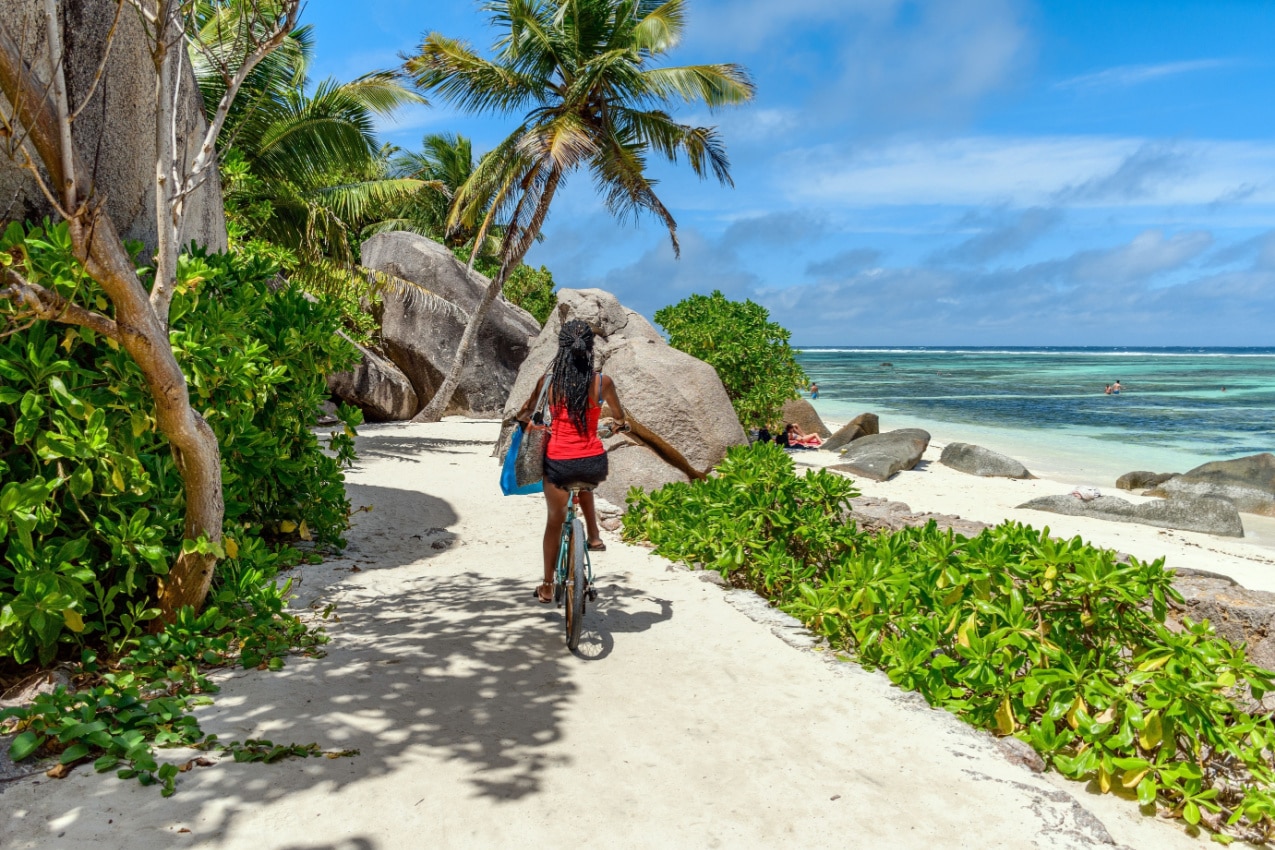
Trade winds play a big role in Seychelles’ weather, bringing heavy rain from November to March and a drier breeze from May to September.
Considering this, the best time to visit Seychelles is during the relatively calm months of April and October.
Spring brings minimal rainfall and more budget-friendly hotel rates, as the peak summer tourist season hasn’t started yet. And if you don’t mind a bit of rain, the post-summer visit in autumn can also save you on hotel and airfare costs, at the same time ensuring ample beach-worthy weather.
Wildlife enthusiasts will love these months. Bird breeding season is in April and May, and migration occurs in September and October. Divers eager to spot migrating whale sharks off Mahé’s northwest coast will have a chance to check them out in October. And let’s not forget that the October-to-December period is nesting season for hawksbill turtles, with females laying up to 200 eggs in the sand.
Some unique creatures live here, too, like Esmeralda, the heaviest wild land tortoise, and rare birds like the bare-legged Scops owl. There’s also a unique plant called Coco de Mer that grows the world’s biggest seed.
April and October have some events going on as well:
- Seychelles Fishing Tournament (April)
- Carnaval International de Victoria (April)
- La Digue Offshore Tournament (October)
- Festival Kreol (October)
If you can’t make it during these months, don’t worry—all seasons can offer you a wonderful Seychelles visit. Summer, particularly July and August, brings the driest weather, and with that, attracts the most crowds. So if you’re a summer enthusiast, plan and book accommodations well in advance, as you may not find a spot or be facing higher prices if you book too close to your visit.
The winter months in Seychelles are perfect for escaping freezing temperatures back home. However, don’t forget to pack a raincoat, as although you’ll enjoy balmy weather, you may have to deal with some rain. Hotel and flight prices might be higher during the winter holidays, so book several months in advance!
How to Stay Safe in Seychelles
- Be Mindful of Personal Items: Avoid flaunting money or valuables, and use your hotel room safe for items like passports, jewelry, and extra cash
- Safety in Desolate Areas: Avoid traveling to remote areas in the middle of the night
- Sun Protection: Carry hats, caps, protective goggles, and sunscreen to prevent sunburn; stay hydrated
- Mosquito Protection: Use mosquito and insect repellent, especially around stagnant water areas
- Leptospirosis Awareness: Be cautious of contaminated water to prevent leptospirosis; we also recommend that you only drink bottled or filtered water
- Beach Safety: Not all beaches have lifeguards; avoid swimming alone at night and watch out for sharp corals and sea creatures
- Drug Offenses: Illegal substances and their transportation are serious offenses; kindly refuse if offered
- Respect Local Norms: Nude or topless bathing for women is uncommon and may not be permitted on some beaches
- Souvenir Rules: Check the legality of taking souvenirs like coral or shells; ensure that they can be legally brought back to your home country
- Coco de Mer Seeds: If purchasing Coco de Mer seeds, ensure they have a green tag for legal transport outside Seychelles
- Have a taxi waiting for you: Download Link-Up and book a taxi using your smartphone.
- Don’t miss your bus and ferry: Check out the schedules on Seychelles Transport (Apple/Google Play) so you don’t have to wait around for the next vehicle
- Opt for food delivery in late hours: Enjoy Seychellois cuisine delivered to your doorstep with FoodChow
- Blend in with the locals: Bridge language gaps with Beginner Seselwa, supporting English and Seselwa, the official language of Seychelles
- Plan your activities in advance: The Seychelles Travel Guide app (Apple/Google Play) will give you some great ideas on how to make the most of your trip
- Stay connected: Purchase an Airtel Seychelles SIM Card for better mobile and internet service
Emergency Numbers
- Police: 999
- Medical Services: 151
- Fire and Rescue Services: 999 or 4 32 32 42
FAQ
Does Seychelles Suffer Pirate Attacks? Piracy in the Indian Ocean rarely reaches Seychelles. Any pirate attacks that do happen in the waters around Seychelles typically target tankers—several dozen nautical miles away from the shore—not tourist boats. However, it’s always smart to research and stay informed before embarking on any yachting adventures.
Seychelles is a welcoming destination for the LGBTQ+ community. The decriminalization of same-sex activities in 2016 marked a positive step, and attitudes are gradually becoming more accepting.
But, real talk, you might still get some side-eye or hear an unnecessary comment if you’re all lovey-dovey in public. If things feel a bit tense, it’s smart to keep things low-key to avoid any unnecessary confrontation. Anyway, the good news is you won’t be in hot water with the law for being you.
The water in Seychelles meets the standards set by the World Health Organization, making it technically safe to drink.
However, on some islands, the water may be heavily chlorinated. Plus, after a significant storm, water sources can get contaminated with dirt and various germs, potentially causing stomach issues. To be on the safe side, go for bottled water.
In Seychelles, the food scene is a tasty blend of influences – French, English, Indian, Chinese – all rolled into the delicious Seychellois Creole cuisine.
The staples are seafood dishes, curries, and an abundance of fresh fruits. But hey, take it easy during the first few days, as diving in too quickly can lead to an upset stomach!
If a local restaurant is buzzing with activity, it’s a good sign that it’s worth trying. If you opt for seafood, just ensure it’s genuinely fresh—if it smells or tastes off, stop eating to dodge seafood-related food poisoning. Some dishes may consider bats, a local specialty, but considering the whole Ebola connection, it’s a hard pass for us. And when grabbing fruits and veggies, go for the unpeeled ones, then wash and peel them yourself, especially if you have a sensitive stomach.
Ending on a High Note!
Seychelles was once a hideout for pirates. Legend has it that a pirate named Olivier Levasseur hid a treasure worth over $100 million that’s still waiting to be discovered. Today, you don’t really have to worry about pirates, but you do need to keep an eye on your stuff, stay up-to-date on weather forecasts, and avoid solo night strolls.
These rules aren’t just for Seychelles; they’re a given wherever you go, whether you’re hitting up another tropical spot like the Maldives, exploring wintry Iceland, or checking out the classics like New York, Paris, and London.
Now that you’re armed with safety know-how, here are your Seychelles must-sees:
- Vallee De Mai, Praslin Island – A UNESCO World Heritage Site, this prehistoric palm forest is the only place where all six palm species in Seychelles grow together, providing a haven for the island’s birdlife.
- Aldabra Atoll – Another UNESCO World Heritage Site, home to the world’s largest population of giant tortoises and their underwater counterparts, turtles.
- Victoria, Mahé – The capital boasts colorful colonial houses, a delightful botanical garden, and a landmark clock tower.
- Copolia Trail, Mahé – Seychelles’ most famous hiking trail offers panoramic views after a 760-foot (231m) ascent.
- St. Anne Marine National Park – Snorkel among vibrant fish, spot turtles, or simply soak in the beautiful surroundings.
Before you start packing, don’t forget your essentials: sun cream, a sunhat, and sunglasses. Bring insect repellent too, as these items can be pricey once you’re there. Finally, to be extra safe, consider bringing a portable CO detector.
We wish you safe and fun travels!
